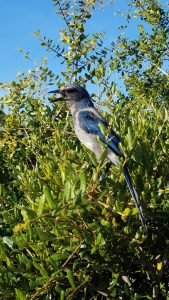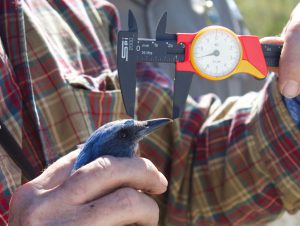
Often teenagers get a bad reputation… sleeping in, laying around on the couch, spending too much time on technology. Not the teenagers of Florida scrub-jays! Florida scrub-jays (Aphelocoma coerulescens) are cooperative breeders, meaning that the young from the previous season, “the teenagers”, stay around their birth territory to help their parents with next season’s young.
If you’ve ever had to care for an infant, I bet you wished for extra help! That’s exactly what these juvenile birds provide. According to Woolfenden and Fitzpatrick, researchers at Archbold Biological Station who have been studying these threatened and unique birds since 1969, juvenile Florida scrub-jays act as sentinels, a designated family member who watches for predators so others can safely eat, build a nest, feed the young, and more. They also help to defend the family’s territory and assist with the feeding of nestlings and fledglings.
Family groups are made up of a monogamous breeding pair, their nestlings, and the young from previous years who have not yet found their own territory and mate. Male birds may even remain helpers far beyond their “teen” time. They may stay at home for up to 6 years before they go out on their own. Cooperative breeding is a great way to get needs met and keep the family safe and well-fed. Very few birds use this strategy for survival. It is just one more way our Florida scrub-jays are unique and special!

Florida scrub-jays are also very busy, caching up to 8,000 acorns each between the months of August to November. Bare sandy areas, a habitat requirement, offer the perfect location for the burying of these high nutrient snacks that are then retrieved during the winter and early spring.
Florida scrub-jays are listed as threatened. They are habitat specialists, meaning they live in a very specific habitat… they like things “just so”. Much of the scrub habitat which they require has been lost over the years and since scrub-jays do not migrate, or fly long distances or very high, many populations are now isolated and diminishing in number and genetic diversity.

Florida scrub-jays are endemic, meaning they are found nowhere else but in our state! This bird is special and unique in so many ways, and yet there are less than 50 individual birds in Sarasota County according to recent surveys. Find out more about Florida scrub-jays and how you can help by attending the Florida Scrub-Jay Festival being held this year at Oscar Scherer State Park on January 11, 2020 from 10am-3pm. Look for our UF/IFAS Extension Sarasota County booth.
Read Dr. Clements’ recent article on scrub-jays in the Venice Gondolier Sun.
Read all our Wild Sarasota blogs HERE
 0
0
